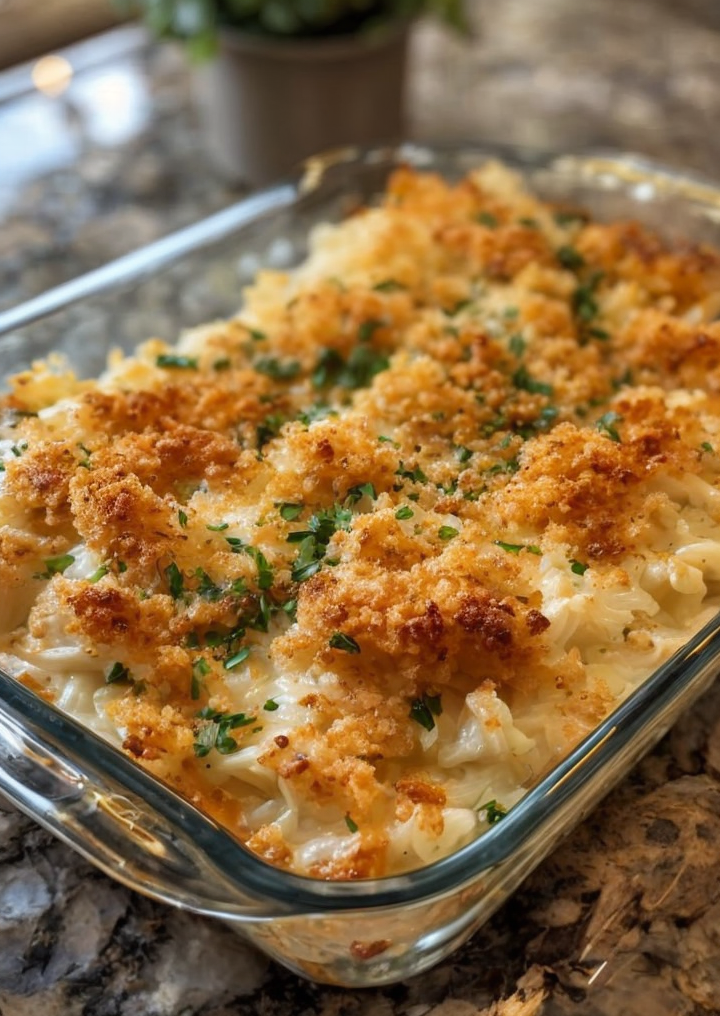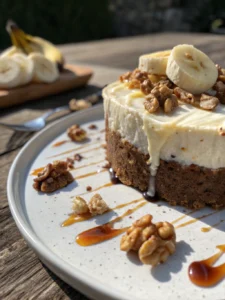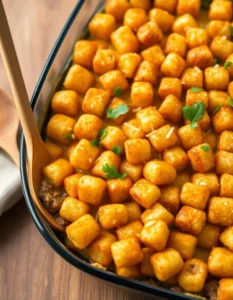Million Dollar Chicken Casserole: A Lavish Delight for Your Dinner Table
Introducing our Million Dollar Chicken Casserole, a decadent dish that promises to elevate your dinner experience. This recipe blends succulent chicken breasts with creamy cheeses and a buttery crust, making it a perfect fit for both family dinners and fancy gatherings. Its rich layers are sure to captivate your taste buds and leave your guests longing for more.
The Million Dollar Chicken Casserole delivers a harmonious balance of savory flavors and luxurious textures that melt in your mouth with every bite. The gourmet quality of this casserole, combined with its straightforward cooking process, makes it a delightful addition to any menu. Whether you are a seasoned cook or a novice in the kitchen, you’ll find this recipe rewarding.
Quick Recipe Highlights
- Flavor Profile: The casserole boasts a blend of creamy, cheesy, and savory flavors, with hints of garlic and herbs, providing a rich and satisfying taste.
- Texture: With a crispy top and a creamy interior, the casserole offers a delightful contrast in textures that appeals to everyone’s palate.
- Aroma: The heavenly scent of melted cheese and baked chicken fills the kitchen, enhancing the anticipation of this comforting dish.
- Visual Appeal: The golden-brown crispy top, rich with bubbling cheese, is visually inviting, promising a sumptuous meal.
- Skill Level Needed: Perfect for all skill levels, this recipe involves simple steps that even a beginner can master.
- Special Equipment: A baking dish and a mixer are essential to blend the ingredients and achieve the perfect bake.
Recipe Overview
- Difficulty Level: The simplicity of preparation makes this dish accessible to everyone, while its gourmet appeal will impress any diner.
- Category: A versatile dish fitting for main courses, or as a centerpiece for special occasions.
- Cuisine: Rooted in comfort food traditions, this casserole is influenced by classic American culinary practices with a touch of elegance.
- Cost: Approximately $15, making it an affordable luxury for those willing to spend a bit more on quality ingredients.
- Season: Ideal for all seasons, the casserole is particularly comforting during cooler months due to its warmth and richness.
- Occasion: Whether a weekday dinner or a festive event, this dish is versatile enough to suit any gathering.
Why You’ll Love This Recipe
Taste and texture appeal is unparalleled, with creamy cheeses contrasting beautifully against a crispy crust. The chicken provides a substantial, meaty bite that delivers satisfaction in every forkful.
Convenience and preparation benefits make this dish an easy choice for weeknights and special occasions alike. The straightforward steps mean less time in the kitchen and more time enjoying with family or guests.
From a nutritional standpoint, this casserole offers high protein content from the chicken, balanced by the richness of cheeses. Further adaptations can enhance its nutritional value, such as adding vegetables or using lower-fat alternatives.
Social and entertaining value is high, as this casserole is a crowd-pleaser that suits various palates. Its luxe appearance and delectable taste mean it often leaves a lasting impression at potlucks or family gatherings.
Cost-effectiveness and accessibility are noteworthy, as most ingredients are budget-friendly and readily available. You can easily keep this dish within your budget by looking for sales or substituting some ingredients with more economical options that maintain flavor integrity.
Historical Background and Cultural Significance
The origin story of the Million Dollar Chicken Casserole traces back to mid-20th century America, where casseroles became popular due to their convenience and versatility. Rooted in the concept of comfort food, this dish has evolved over decades, prioritizing indulgence and ease.
Culturally, casseroles like this one have played an important role in American dining, representing shared meals and potlucks where community bonds over hearty dishes. They’ve become synonymous with nurturing and hospitality, making them a staple at gatherings.
Over the years, this casserole has evolved with varied adaptations to suit different tastes and dietary needs, incorporating regional ingredients or health modifications, while still holding true to its opulent roots.
Regional variations can be seen across the United States, with the addition of local spices or alternative proteins to enhance flavor profiles. Each variation offers a unique twist while keeping the essence of the dish intact.
Ingredient Deep Dive
Chicken breasts form the cornerstone of this recipe, providing a lean and protein-rich base. Culturally, chicken remains a staple worldwide for its versatility and wide acceptance across cuisines. Nutritionally, it’s a low-fat, high-protein meat that supports muscle growth and repair.
Selection tips for chicken include choosing organic or free-range options for superior quality and taste. Freshness is key, ensuring the best possible flavor and texture in the casserole.
Cheddar and cream cheese blend seamlessly to create a creamy layer. Cheddar imparts a sharpness that contrasts with the mild, smooth creaminess of cream cheese. Nutritionally, cheese offers calcium and protein, but mindful use is advisable due to higher fat content.
Opt for freshly grated cheddar for easier melting and enhanced flavor. Storage of cheese should be airtight in the fridge, and substitutions can include mozzarella or gouda based on preference.
Common Mistakes to Avoid
- Overcooking chicken can dry it out, so monitor closely while baking.
- Using pre-shredded cheese, which often doesn’t melt as smoothly; opt for fresh blocks.
- Skipping seasoning can result in a bland casserole; ensure adequate spice use.
- Not allowing casseroles to cool slightly, which impacts serving and taste.
- Baking at too high a temperature risks burning the top before the inside is fully cooked.
- Undercooking the casserole leaves ingredients unintegrated; follow time guidelines.
- Wrong dish size affects cooking times and consistency; use the recommended size.
- Ignoring substitutions’ effect on texture and flavor; adapt knowledgeably.
Essential Techniques
Mastering the chicken preparation ensures succulent results. Properly seasoning and evenly cooking the chicken through pan-searing or baking in advance adds depth to your casserole dish.
Mixing cheeses before layering ensures a consistent cheesy coating throughout. This technique avoids clumping and allows flavors to meld seamlessly.
Creating a balanced béchamel (if included) is crucial for a creamy finish. Understanding consistency and temperature controls helps prevent separation and maintains the casserole’s luscious texture.
Sprinkling breadcrumbs or additional cheese for topping should be done with care. This step adds a crunchy layer, balancing the soft, creamy interior.
Understanding baking dynamics, such as convection versus conventional ovens, impacts texture and browning during the bake.
Pro Tips for Perfect Million Dollar Chicken Casserole
Allow your casserole to rest after baking to allow layers to meld, resulting in a more cohesive and flavorful dish when serving.
Use room temperature cream cheese for easier mixing and a smoother texture, enhancing the consistency of the cheese blend.
Add herbs like thyme or rosemary for an aromatic upgrade that complements the casserole’s creamy flavors.
Roast vegetables like broccoli or bell peppers before incorporating to introduce added flavor and fiber.
Choose a sharp cheddar for zesty depth, aligning for extra-strong characteristics that counteract the creamy texture.
For a crispy top, briefly broil the casserole after baking, keeping an eye to prevent burning and achieve that golden crunch.
Balance salt carefully, focusing on a subtle enhancement of flavors without overpowering.
Utilize single-ingredient spices to closely monitor flavor enhancements, avoiding the risk of overpowering blends.
Variations and Adaptations
Regional variations could incorporate local cheeses or seasonings that introduce distinct flavor profiles, ensuring a unique twist from classic renditions.
Seasonal adaptations involve adding fresh produce based on time of year, like squash in autumn or asparagus in spring, supporting sustainable and conscious cooking.
Dietary modifications include using lactose-free cheeses or opting for plant-based meats and fish to adapt the casserole for vegan or vegetarian diets.
Flavor variations can be achieved by introducing spices like paprika for heat or nutmeg for warmth, offering an upgraded dimension to the casserole.
Texture modifications, such as adding crushed nuts to the top, can diversify the mouthfeel with a crunchy surprise against the creamy dish.
For presentation alternatives, consider individual ramekins for a personalized touch at each serving, enhancing visual presentation and portion control.
Serving and Presentation Guide
Employ elegant plating techniques by pairing portions with fresh herbs and a drizzle of cheese sauce for added color and life to the plate.
Optimize garnishing ideas with finely chopped parsley or chives, bringing fresh green vibrancy and highlighting the casserole’s warm tones.
Traditional accompaniments can include buttery rolls or a light salad, providing balance to the casserole’s richness.
For modern serving suggestions, consider a tapas-style dinner incorporating small portions with a variety of side dishes.
Temperature considerations emphasize a warm serving temperature to maintain cheese melt and overall decadence but avoid overheating which could alter taste.
Portion control tips recommend pre-slicing servings, easing dishing and managing caloric intake, ensuring enjoyment without over-indulgence.
Wine and Beverage Pairing
Consider a lightly oaked Chardonnay, as it complements the creamy profile while balancing the rich cheese with its crispness and acidity.
For non-alcoholic alternatives, enjoy with sparkling water enhanced by citrus slices, offering refreshment without overpowering flavors.
Explore complementary coffee or tea pairings for dessert, such as green tea, whose subtlety complements the savory casserole.
Temperature hints suggest serving chilled, lighter-bodied beverages to counterbalance dish warmth.
Elegant serving recommendations maintain simple, sturdy glassware, avoiding complex designs that distract visually from the dish.
Storage and Shelf Life
Proper storage methods involve refrigerating leftovers in airtight containers, ensuring cheese flavors and textures remain intact.
Temperature requirements are crucial; maintain at standard refrigeration temperatures, avoiding zones that promote bacteria.
Use freezer-friendly containers if planning to store longer-term, allowing casseroles to retain their composition when thawed.
Recognize signs of spoilage like off color or smells, ensuring the dish’s freshness and safety.
For reheating, cover casserole with foil to avoid top burning, using lower oven temperatures to achieve even heating.
Freezing guidelines suggest dividing into portion sizes, aiding efficient thawing and reheating while preserving overall quality.
Make Ahead Strategies
Plan a prep timeline involving ingredient assembly a day before, reducing workload on the day of serving.
Strategize storage between steps for any prepared elements, avoiding undesired texture changes by adhering to environmental controls.
Assess quality impact whenever ingredients are prepared in advance, ensuring optimal results for the final bake.
Offer assembly tips for creating layered flavors, optimizing textures and tastes through well-structured composition.
Reheating requires uniform application of heat to maintain moisture and ensure complete warming, aiming for a freshly-made feel.
Incorporate fresh element additions, using fresh herbs to reinvigorate pre-prepared dishes or stepping up served impact.
Scaling Instructions
Halving the recipe involves precise measurement adjustments, ensuring proportions maintained to avoid altered taste or texture.
Doubling or tripling calls for larger equipment, like bigger mixing bowls or baking dishes, accommodating increased volumes.
Adjust oven timing to ensure even cooking when scaling, altering when need arises to avoid undercooking or overbaking.
Proper storage considerations remain essential for maintaining quality across scaled amounts, addressing space and food safety.
Equipment adjustments may include mixing bowl selection and utensil sizing, allowing mixture handling with ease.
Nutritional Deep Dive
Macro breakdown emphasizes protein from chicken, fats from cheeses, and carbs chiefly derived from crust and any added sides.
Micronutrient analysis reveals significant calcium, vitamin D, and iron from ingredients like cheese and chicken.
Highlight health benefits, promoting protein intake from chicken’s lean cut, balancing creamier elements appropriately.
Dietary considerations advise moderation with cheese and crust components for health-conscious dining.
Portion analysis aids weight management, calculating appropriate serving numbers that align with dietary goals.
Weight management tips include serving with a vegetable side, balancing the nutrition profile while ensuring satisfaction.
Dietary Adaptations
Gluten-free adaptations suggest opting for gluten-free flour in crusts or omitting it for a crustless casserole, while using gluten-free breadcrumbs.
Dairy-free modifications require alternative cheeses, sourcing plant-based creamy replacements like almond or soy-based cheeses.
Vegan alternatives involve substituting meats and cheeses completely, focusing on plant-based offerings that align with vegan guidelines.
Low-carb focuses on removing higher carbohydrate crust components, exploring almond or coconut-based alternatives for taste compatibility.
Keto adaptation maintains consistency with high-fat cheeses while reducing carbohydrate components strategically in preparation.
Paleo guidelines may involve choosing cheeses with less processing or decoration, remaining focused on minimal processing.
Low-FODMAP adaptations involve ingredient checks, ensuring use of lactose-free cheeses, and monitored garlic/herb application.
The Recipe
Million Dollar Chicken Casserole
Serves: 6
Prep Time: 20 mins
Cook Time: 30 mins
Total Time: 50 mins
Kitchen Equipment Needed
- Baking dish
- Mixing bowl
- Foil
- Oven mitts
- Whisk
Ingredients
- 1 lb chicken breasts, cooked and shredded
- 1 cup cheddar cheese, shredded
- 8 oz cream cheese, softened
- 1/2 cup sour cream
- 1/4 cup mayonnaise
- 1 tsp garlic powder
- 1/4 cup bread crumbs
- Salt and pepper to taste
Directions
- Preheat your oven to 350°F (175°C).
- In a large mixing bowl, combine cream cheese, sour cream, mayonnaise, garlic powder, salt, and pepper, mixing until smooth.
- Fold in shredded chicken and cheddar cheese, ensuring even coating.
- Transfer mixture into a greased baking dish, spreading it evenly.
- Sprinkle bread crumbs over the top, creating a uniform layer.
- Bake in preheated oven for 30 minutes, or until the top is golden and bubbly.
- Let rest for 10 minutes before serving, allowing flavors to meld.
Recipe Notes
- Feel free to add steamed vegetables for extra nutrition.
- Use rotisserie chicken for a time-saving step.
- Chives or parsley make excellent garnishes.
Troubleshooting Guide
Recognize texture issues that may arise from mixing techniques, ensuring smooth incorporation between steps and proper oven monitoring.
Flavor balance often needs adjustment through seasoning, so taste-test before baking to tweak to your taste profile.
Control temperature problems with accurate oven handling, avoiding spikes that skew final dish outcomes.
Address equipment challenges, employing kitchen basics to avoid improvisation shortening potential or efficiency.
Address ingredient substitutions like cheese types with knowledge understanding, recognizing differences in performance.
Timing concerns, such as overcooking, can be monitored through accurate step execution and consistency checks.
Recipe Success Stories
Community feedback has been overwhelmingly positive, with many readers confirming how this recipe quickly becomes a favorite in household rotations.
Variation successes have included adding spicy elements for an extra kick, echoing feedback stories and delighting spice aficionados.
Adaptation stories shared speak to gluten-free modifications achieving ideal results while maintaining dish integrity.
Reader suggestions have inspired creative spins on the original, expanding the community’s repertoire and encouraging continued exploration.
Photography tips remind all to capture those golden-brown casserole tops, highlighting ingredient gloss in well-lit environments to share online proudly.
Frequently Asked Questions
Can I use leftover roast chicken?
Absolutely, leftovers streamline prep, infusing roasted flavors into your casserole mix naturally.
How do I adjust seasonings?
Start with minimal salt/pepper at first, gradually adjusting post-mixing after initial tasting sessions.
Should the cream cheese be cold?
Using softened cream cheese yields a smoother, easy-to-manage mixing phase for even blending.
Can I make this casserole vegetarian?
Certainly, replace chicken with hearty mushrooms or protein-rich seitan to suit your needs.
Best cheesecake substitute cheeses?
Consider ricotta or mascarpone when catering cheese alternatives, maintaining creaminess.
How spicy should it be?
Spice levels are customizable, adjusting garlic or including hot sauce for personalized taste profiles.
Will honey or sugar sweeten?
These could unbalance savory focuses, explore herb or spice enhancements over sweet alternatives.
Why is the top not crisp?
Evaluate breadcrumb application or broil slightly for further crisp optimization, monitoring constantly.
Is canned chicken suitable?
It’s possible and reduces prep time, though taste and texture benefit typically from fresh ingredients.
Can I add Top seven allergies concerns ingredients?
Adjust accordingly for sensitivities by cross-referencing allergen details among ingredients list; careful substitutions boost inclusivity.
Do condiment modifications impact other flavors?
Switch up sparingly, mitigating overpowering flavor risk—balance fundamental base without overpowering additives.
Ideal bakeware beyond casserole dish?
Opt wider dish options promoting even heat distribution and limited elevation rise for cook consistency.
Additional Resources
Dive into related recipes such as breaded chicken for similar ingredient methodologies, exploring upto their creative constellations among broader cuisines.
Technique guides cover complementary pairing principles, extending understanding into building blocks across everyday meals.
Ingredient information envelopes enriched educational focuses, thereby expounding storage steps or identifying region-linked benefits.
Explore equipment recommendations, covering valued investments or beginner basics for its equipped optimality spotlighted additions.
Seasonal variations extend varietal reaches universally to suit climates or accentuate potential delicious discoveries available, yet untasted!
Join the Conversation
Elevate community sharing with dynamic social media shots, emphasizing visual stories for ingredient interactions spontaneously curated.
Harness photography tips to showcase plate finesse, incorporating delicate presentation reflections portraying how method meets enjoyment.
Encourage recipe reviews welcoming feedback in tune with potential altercations or highlights when connecting wider with fellow enthusiasts.
Embrace community engagement across recipe boards or culinary hobby groups, introducing neighbors, family, and friends to newfound gems.
Explore adaptable avenues, pertaining to further suggestion abilities enriching narrative sharing discussions extending possibilities within online frameworks.



